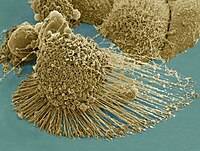
Photo from wikipedia
Immortalization (genetically induced prevention of replicative senescence) is a promising approach to obtain cellular material for cell therapy or for bio-artificial organs aimed at overcoming the problem of donor material… Click to show full abstract
Immortalization (genetically induced prevention of replicative senescence) is a promising approach to obtain cellular material for cell therapy or for bio-artificial organs aimed at overcoming the problem of donor material shortage. Immortalization is reversed before cells are used in vivo to allow cell differentiation into the mature phenotype and avoid tumorigenic effects of unlimited cell proliferation. However, there is no certainty that the process of de-immortalization is 100% effective and that it does not cause unwanted changes in the cell. In this review, we discuss various approaches to reversible immortalization, emphasizing their advantages and disadvantages in terms of biosafety. We describe the most promising approaches in improving the biosafety of reversibly immortalized cells: CRISPR/Cas9-mediated immortogene insertion, tamoxifen-mediated self-recombination, tools for selection of successfully immortalized cells, using a decellularized extracellular matrix, and ensuring post-transplant safety with the use of suicide genes. The last process may be used as an add-on for previously existing reversible immortalized cell lines.
Journal Title: International Journal of Molecular Sciences
Year Published: 2023
Link to full text (if available)
Share on Social Media: Sign Up to like & get
recommendations!